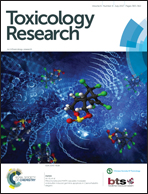Regulating temperature and relative humidity in air–liquid interface in vitro systems eliminates cytotoxicity resulting from control air exposures
Abstract
VITROCELL® systems permit cell exposures at the air–liquid interface (ALI); however, there are inconsistent methodologies in the literature for their operation. Some studies find that exposure to air (vehicle control) induced cytotoxicity relative to incubator controls; others do not mention if any cytotoxicity was encountered. We sought to test whether temperature and relative humidity (temp/RH) influence cytotoxicity with an unmodified (conditions A & B) and modified (condition C) VITROCELL® 6 CF with temp/RH controls to permit conditioning of the sampled air-flow. We exposed BEAS-2B cells for 1 h to air and measured viability (WST-1 cell proliferation assay) and lactate dehydrogenase (LDH) release 6 h post-exposure. Relative to controls, cells exposed to air at (A) 22 °C and 18% RH had a 47.9% ± 3.2% (p < 0.0001) reduction in cell viability and 10.7% ± 2.0% (p < 0.0001) increase in LDH release (B) 22 °C and 55% RH had a 40.3% ± 5.8% (p < 0.0001) reduction in cell viability and 2.6% ± 2.0% (p = 0.2056) increase in LDH release, or (C) 37 °C and >75% RH showed no changes in cell viability and no increase in LDH release. Furthermore, cells exposed to air at 37 °C and >75% RH 24 h post-exposure showed no changes in viability or LDH release relative to incubator controls. Thus, reductions in cell viability were induced under conditions used typically in the literature (conditions A & B). However, our modifications (condition C) overcome this shortcoming by preventing cell desiccation; regulating temp/RH is essential for conducting adequate ALI exposures.



 Please wait while we load your content...
Please wait while we load your content...